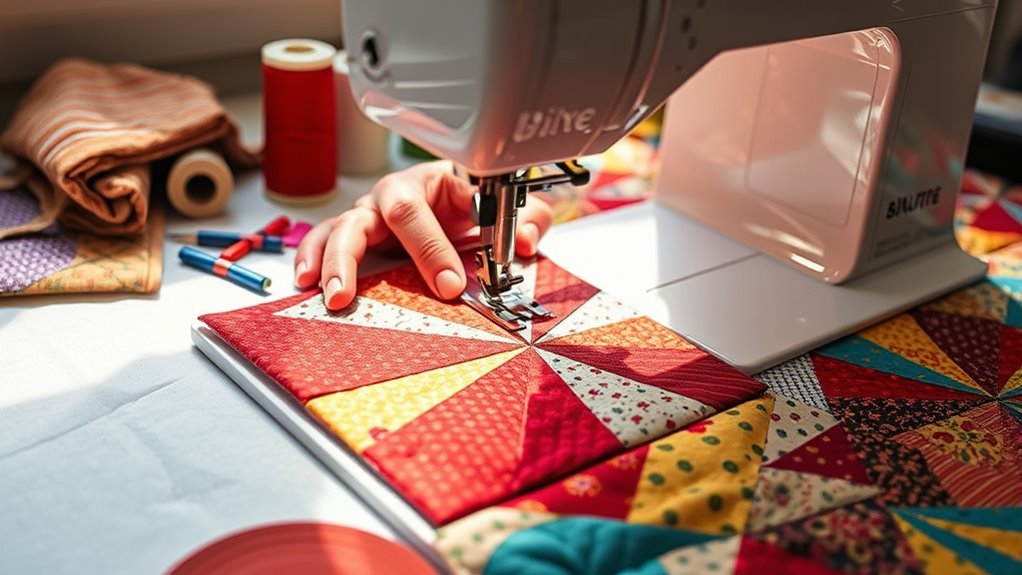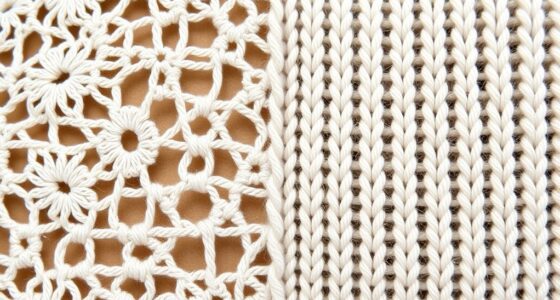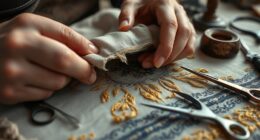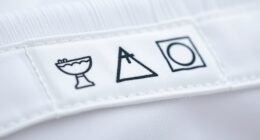To sew your first quilt block, start by choosing fabrics that complement each other, keeping in mind color, pattern, and texture. Gather essential tools like a rotary cutter, ruler, pins, and your sewing machine. Carefully cut your fabric pieces with accuracy, then pin them in place before sewing with a consistent seam allowance. Press seams flat for a professional finish. With patience and attention to detail, you’ll create a beautiful block—keep going to master the entire quilting process.
Key Takeaways
- Select coordinating fabrics and cut precise pieces using a rotary cutter, ruler, and cutting mat.
- Pin or clip fabric layers together to prevent shifting before sewing.
- Sew fabric pieces with a consistent 1/4-inch seam allowance, following your pattern.
- Press seams flat with an iron to ensure accurate block assembly and reduce bulk.
- Check measurements frequently and take your time for a neat, professional-looking quilt block.
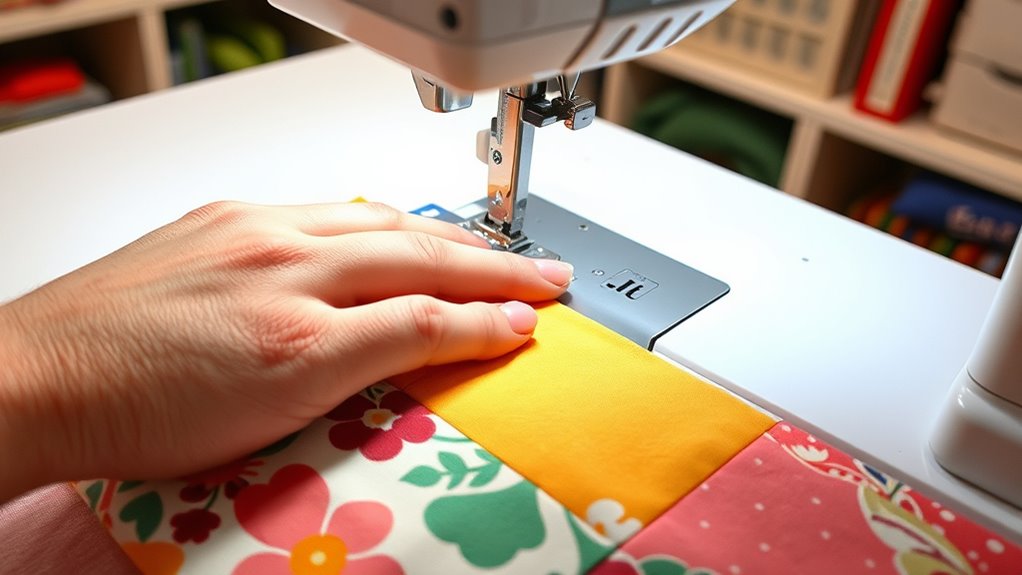
Have you ever wondered how a simple collection of fabric pieces transforms into a beautiful quilt? It all begins with fabric selection. Picking the right fabrics is essential because it sets the tone for your entire project. You want fabrics that complement each other in color and pattern, but also consider their texture and weight. Cotton is a popular choice for quilting because it’s easy to work with, durable, and washes well. When selecting fabric, think about contrast; combining light and dark shades helps your quilt blocks stand out. Also, consider the theme or mood you want to convey—bright, cheerful, or subdued. Once you’ve chosen your fabrics, it’s time to gather your quilting tools. Having the right tools makes sewing easier and more precise. Necessary quilting tools include a rotary cutter, cutting mat, quilting ruler, pins or clips, a sewing machine, and thread. The rotary cutter and cutting mat allow you to cut fabric pieces accurately, which is critical for neat seams. The quilting ruler helps measure and cut straight lines, ensuring your pieces fit together perfectly. Pins or clips hold fabric layers in place while you sew, preventing shifting and uneven seams. Your sewing machine should be set to the correct stitch length for quilting, typically a standard straight stitch. Good quality thread that matches or complements your fabric enhances the durability and appearance of your finished quilt. Additionally, understanding the importance of accurate cutting can significantly improve the overall quality of your quilt blocks. Before starting, lay out your fabric pieces to visualize how they’ll come together. Use your quilting tools to cut each piece precisely, following your pattern or design. Precision in cutting is key because even small mistakes can throw off the entire block. When you’re ready to sew, align your fabric edges carefully, pin or clip them, and sew along the seam with a consistent seam allowance—usually 1/4 inch. Press each seam flat with an iron as you go; this helps reduce bulk and ensures your block stays square. Take your time during each step, checking measurements often. The right fabric choices combined with your quality quilting tools make the process smoother and help you achieve a polished look. As you sew your first block, remember that patience and attention to detail are your best allies. With practice, your skills will improve, and you’ll gain confidence in creating more complex designs. The joy of quilting lies in the process as much as the finished product, so enjoy each step and celebrate your progress along the way.
Frequently Asked Questions
What Types of Fabrics Are Best for Beginner Quilting?
For beginner quilting, you should choose cotton fabrics because of their ease of fabric selection and durability. Cotton is sturdy, washes well, and handles easily, making it perfect for your first quilt block. Stay away from delicate or stretchy fabrics, as they’re harder to sew consistently. By picking durable, easy-to-work-with fabrics like quilting cotton, you’ll find the process more enjoyable and your finished quilt will last longer.
How Do I Choose the Right Thread for Quilting?
You should choose thread color based on whether you want it to blend or stand out. For a subtle look, match the thread to your fabric; for contrast, pick a bold color. Consider thread thickness choices: thinner threads work well for detailed quilting, while thicker threads add texture. Always opt for high-quality quilting thread to guarantee durability, smooth sewing, and a professional finish on your first quilt.
What Tools Are Essential for Starting a Quilting Project?
To begin your quilting project, you’ll need essential tools like a rotary cutter for precise fabric cuts and a cutting mat to safeguard your surfaces. Hand sewing needles and quality thread help you finish details or small projects. A quilting ruler ensures accuracy, and pins or clips keep fabric layers aligned. These tools make your quilting process smoother, helping you create beautiful, professional-looking quilt blocks with confidence.
How Can I Fix Common Mistakes in Quilt Blocks?
When fixing common mistakes in quilt blocks, start by checking your seam allowances to make sure they’re consistent. If your fabric alignment is off, carefully rip the stitches and re-sew, aligning edges precisely before pressing. Use a ruler or quilter’s ruler to straighten any crooked seams. Taking your time to re-align fabric and maintain proper seam allowances will help fix mistakes and improve your quilt’s overall look.
What’s the Best Way to Wash and Care for My Quilt?
Think of your quilt as a cherished friendship—gentle care keeps it bright. Wash it on a delicate cycle with cold water, using mild detergent to safeguard the fabric maintenance. Avoid harsh chemicals and bleach, which can weaken fibers. Air dry or tumble dry on low. This careful approach ensures your quilt’s colors stay vibrant, and its stitches stay strong, helping you preserve its beauty and warmth for generations to come.
Conclusion
Now that you’ve sewn your first quilt block, you’re well on your way to creating beautiful, cozy blankets. Remember, quilting is like planting a garden – with patience and practice, your skills will grow, and your projects will flourish. Keep experimenting, have fun, and don’t get discouraged by little mistakes. Before you know it, your quilting journey will be a tapestry of colorful memories and handmade masterpieces that warm both your home and your heart.

